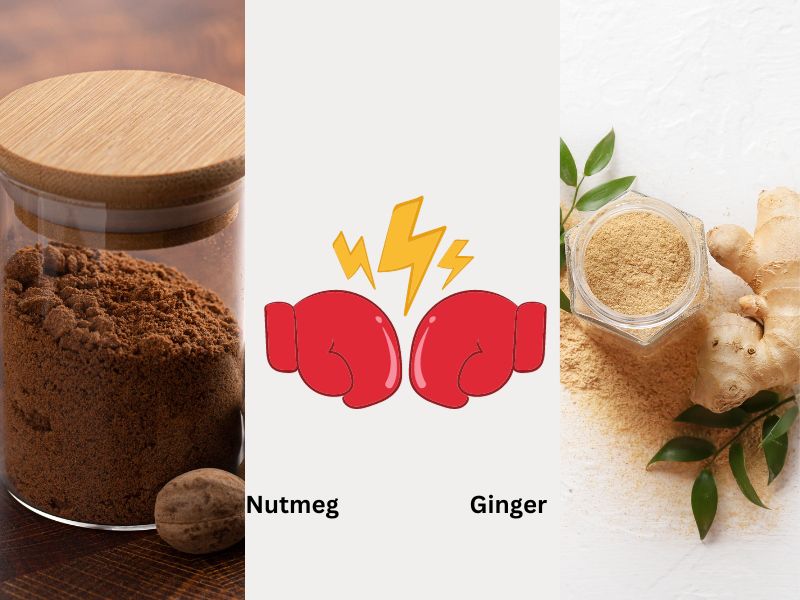When it comes to baking, spices can be the magic touch that can change a good dessert into an unforgettable one. But like in music, not all notes harmonize perfectly, so the question is, which spices don’t play well together? Let’s find out!
The Role of Spices in Baking
Spices are truly the unsung heroes of baking. Not only do they add flavor, but they also breathe life into our baked goods. A dash of cinnamon can elevate a basic dough, turning it into a delightful treat, while a hint of nutmeg adds depth and warmth to both cookies and cakes.
But it’s not just about taste. The aroma of spices, like the comforting scent of freshly baked gingerbread, can fill a room, reminding us of cherished memories and setting a cozy mood. Visually, spices like saffron can give a beautiful golden color to dishes, and cocoa powder can lend a deep, rich brown.
Some spices even influence texture; for instance, cloves can introduce a subtle crunch, and ginger might add a touch of moisture. Apart from their delightful flavors, spices often bring health perks too
Consider cinnamon, recognized for its antioxidants, or turmeric, praised for reducing inflammation. In baking, spices aren’t just add-ins; they’re the special touch that transforms basic recipes into masterpieces, letting bakers create treats that please the senses and boost health
Commonly Used Spices in Baking
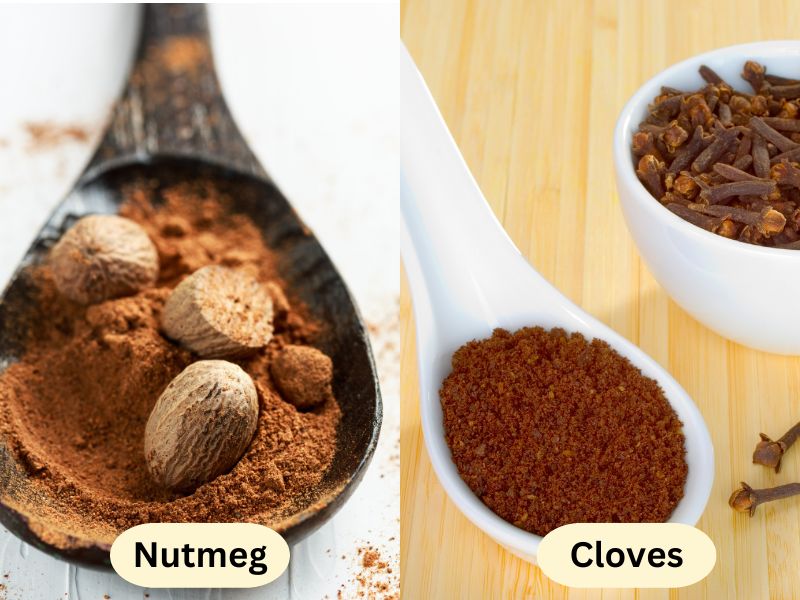
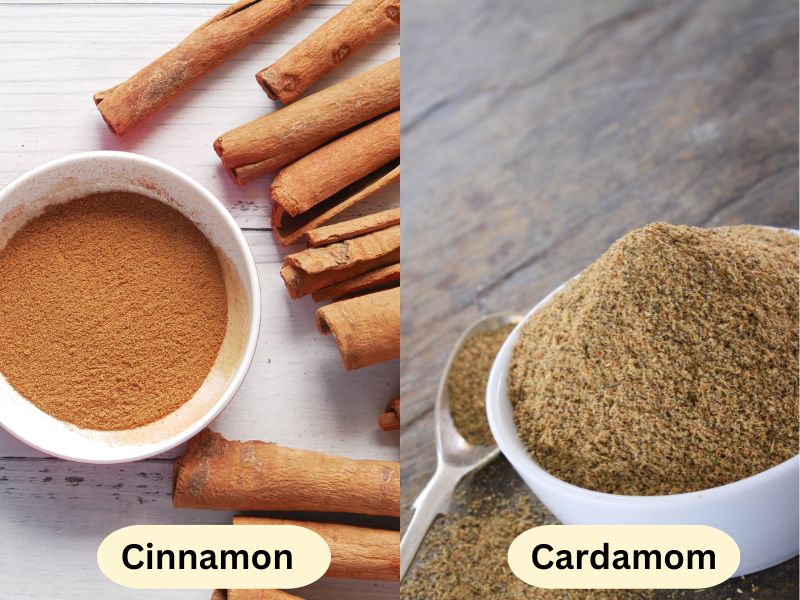
In the wide world of baking, certain spices have become staples, each bringing its unique flavor profile and charm to a variety of desserts. With its sweet and woody aroma, Cinnamon is often the star in many pastries, from cinnamon rolls to apple pies. Its versatility makes it a favorite among bakers.
Then there’s nutmeg, a spice that offers a warm and slightly nutty flavor. It’s the secret ingredient in many holiday treats, especially eggnog and pumpkin pies.
Cloves are another aromatic spice, known for their intense and pungent taste. They’re typically used sparingly, but when added, they can give a dish a deep, spicy undertone that’s unmistakable.
On the other hand, Cardamom is a bit of an exotic addition to the baking spice family. Its unique spicy-citrusy flavor is often found in Scandinavian pastries and Indian desserts.
And let’s not forget vanilla, although more of a flavoring than a spice, it’s a key ingredient in baking, providing a sweet, creamy base note that enhances other ingredients. These spices, among others, are the building blocks of flavor in baking. Knowing how to use them effectively can transform a good dessert into a great one, creating layers of taste that delight the tongue.
Spice Mixtures to Use with Care

Using spices in baking can be tricky. Some mix well and taste great, while others don’t. Take cinnamon and cloves, for example. Both are bold spices and might clash if you use them equally. Using more cinnamon than cloves is usually better to get the right taste.
Be careful when mixing nutmeg and ginger. On their own, they add a cozy taste to baked stuff. But together, they can be too strong and hide each other’s unique flavors. It’s like having two main singers in a song – sometimes, one should sing a bit softer to let the other stand out.
Then there’s the combination of cardamom and allspice. Both spices have robust and distinct flavors. Cardamom can easily overshadow allspice’s more complex, peppery warmth with its citrusy and slightly minty notes. It’s important to find a balance when using them together, maybe by using cardamom as an accent rather than the main flavor.
In baking, as in music, harmony is key. While experimenting with spice combinations can lead to delightful discoveries, it’s also important to approach certain pairings with a bit of caution and knowledge. This helps to make sure that every bite offers a balanced and enjoyable flavor.
Why Some Spices Don’t Mix Well
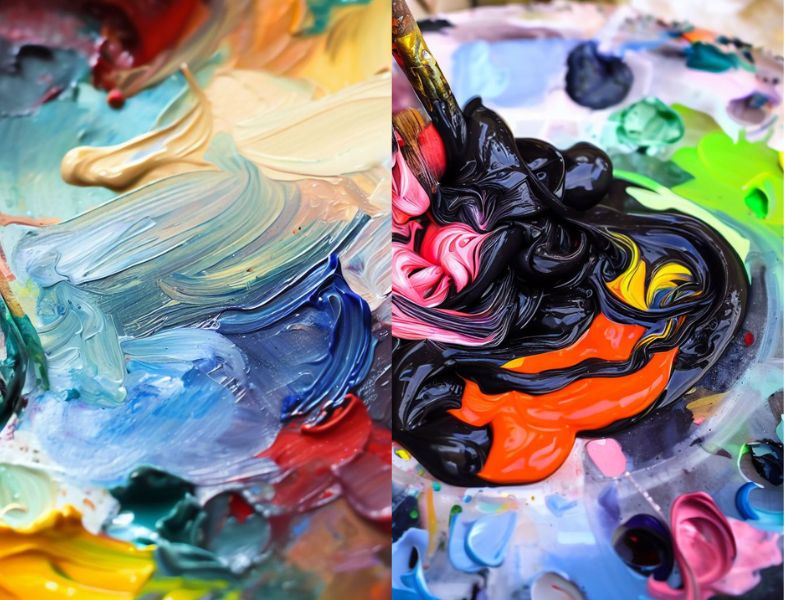
The world of spices is not just about tantalizing our taste buds; there’s a deep-rooted science that governs how these flavors interact with each other. When we talk about spices that might not mesh well together, it’s important to understand the ‘why’ behind these clashes.
At the heart of this are the flavor profiles of each spice. Every spice has a unique set of compounds that contribute to its taste and aroma. When combined with two spices with overlapping or competing flavor compounds, they can mute each other or create an overpowering taste. It’s similar to mixing colors; certain shades enhance each other, while others can produce a muddled color.
Beyond just flavor, the chemical composition of spices plays a significant role. Some spices can affect the acidity or alkalinity of a dish. For instance, spices rich in acids might not pair well with those that are alkaline, leading to changes in the texture or consistency of the baked goods. This is really important in recipes like cakes where the right mix matters.
For example, You are baking a lemon cake. Lemons are sour (or acidic), and you add baking soda, which is the opposite of sour (or alkaline), to help the cake rise. If you add another sour ingredient like cream of tartar, the cake might not rise properly because there’s too much sourness. But if you add a neutral spice like ground coriander, the cake will rise just fine. So, it’s important to know how spices affect your baking, especially for recipes where getting it right is crucial.
Spices have oils that give them their smell. Sometimes, two spices might taste good together, but their smells can clash, leading to a weird or bad scent.
Lastly, it’s worth noting the health interactions of certain spices. While spices are known for their health benefits, certain combinations might reduce these benefits or, in rare cases, produce undesirable effects when consumed in large quantities.
In short, spices make our food tasty, but knowing how they work together helps us use them best, making yummy and balanced dishes.
Tips for Successful Spice Pairing
| 🍪 Handy Tips for Pairing Spices 🌶️ | |
|---|---|
| 1. Start with a Base Spice | Choose one primary spice to set the tone for your dish. |
| 2. Complementary vs. Contrasting Flavors | Recognize when to aim for harmony and when to introduce contrast. |
| 3. The “Less is More” Philosophy | Avoid overwhelming the dish with too many spices. |
| 4. Freshness Matters | Ensure your spices are fresh for the best flavor. |
| 5. Adjust and Taste | Taste as you go and adjust spice quantities based on preference. |
| 6. Research Traditional Pairings | Explore traditional spice combinations for inspiration. |
| 7. Consider Texture and Mouthfeel | Be mindful of how the physical form of the spice affects the dish. |
| Brought to You by wearebaking.com 🍰 | |
Getting good at mixing spices in baking can take your baked goods from nice to top-notch. While trusting your gut and liking matters, there are some proven tips to make sure your spice mixes are always on point.
1. Begin with a Main Spice: Imagine your dessert like a blank slate and pick one main spice to shine. This spice will shape the taste of your dish. For example, in a spiced cake, cinnamon can be the main flavor, giving a cozy and sweet base for other tastes to add on
2. Some spices, like vanilla and nutmeg, go well together, giving a smooth mix. But spices like ginger and clove have different tastes that can make a dish more interesting. Know when to mix spices that match and when to add some fun difference
3. .Using too many spices can confuse the taste. Often, it’s best to keep it simple. A dessert focusing on just one or two spices lets those tastes stand out without overwhelming the taste buds.”
4. Spices lose their strength as they age. Make sure your spices are always fresh because old ones can make food taste dull or odd. Keep an eye on your spice collection and replace them when needed.
5. Baking is as much an art as it is a science. Don’t be afraid to adjust spice quantities based on your taste preferences. Always taste as you go, and remember that you can always add more, but you can’t take away.
6. Many cultures have traditional spice combinations that have been perfected over centuries. Exploring these can provide inspiration. For instance, the Middle Eastern blend ‘Za’atar’ or the Indian ‘Garam Masala‘ offer balanced combinations that can be incorporated into baking.
7. Some spices, like star anise or whole cardamom pods, can change the texture of your baked items. Think about how the actual shape of the spice might change how it feels when eaten.
In the end, successful spice pairing is about exploration and understanding. By keeping these tips in mind and being open to experimentation, you can craft desserts that are a symphony of flavors, delighting the senses with every bite.
Experimenting with Spice Blends
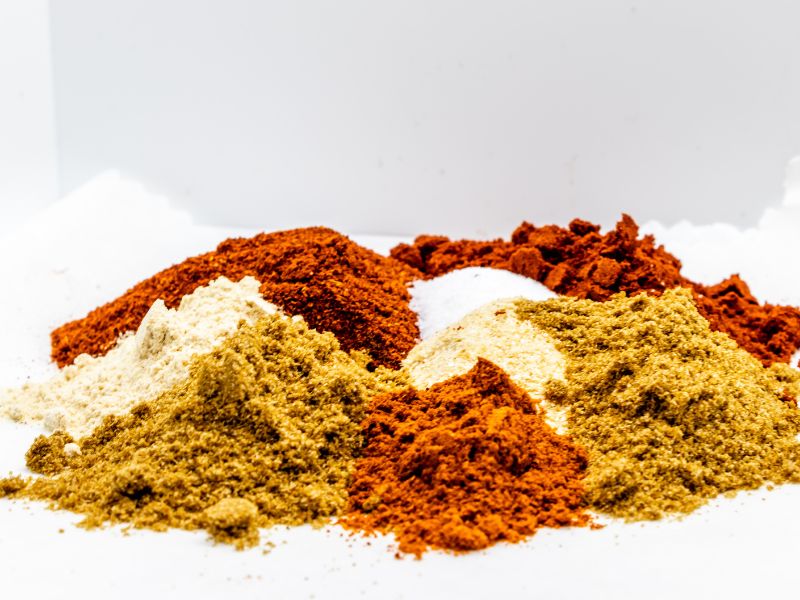
Baking is like a flavor adventure. Mixing spices is how you make something special. While each spice has its own taste, putting them together can make a dish even more amazing
The Magic of Pre-made Blends
Time-tested spice blends have their charm. Consider Pumpkin Spice, which combines cinnamon, nutmeg, ginger, cloves, and allspice. It embodies the spirit of autumn and is a favorite in pies, lattes, and more. Like-wise, Chai Spice, blending cardamom, cinnamon, ginger, cloves, and black pepper, brings a cozy cup of tea to mind. These classic mixes offer a well-rounded taste, making them excellent bases for baking adventures.
Crafting Your Own Signature Blend
While relying on traditional mixes is great, you can also make your own. Start by deciding the taste you’re aiming for. Do you want it to be warm, cozy, or maybe zesty and lively? With a direction in mind, mix spices in small quantities, tweaking the amounts until you strike the right balance.
Document Your Discoveries
Whenever you hit upon a fantastic mix, write it down. Keeping track of your unique blends ensures you can recreate them consistently and refine them further with each bake.
Consider the Purpose
Different baked items need varying spice strengths. For instance, a rich fruitcake can take on a strong spice mix, while a light sponge cake might need a gentler touch. Think about the final dish when deciding on your spice blend.
Storage is Key
After making your blend, keep it in a sealed container away from sunlight. This will keep the flavors strong and the mix fresh for longer.”
Experimenting with spice blends is a journey of discovery. It’s about understanding the flavors and aromas of each spice, how they interact, and how they can come together to create something truly special. So, roll up your sleeves, trust your taste, and begin an adventure that’s bound to yield delicious results.
Final Thoughts
Exploring the world of baking spices is both a craft and a study. Spices can turn a basic dessert into a standout dish with their distinct tastes and scents. However, knowing how they work together is important. Some spices blend perfectly, giving a delightful taste, while others might not mix well, leading to surprising outcomes. The secret is to get the hang of spice combinations, spot potential mismatches, and always be ready to try something new. Whether you’re using classic blends or making your own unique mix, your spice journey promises to be rich and eye-opening. As you bake, trust your taste buds and always stay curious.
Have you mixed spices that didn’t turn out well? Please leave me a comment below
And As Always
Keep On Baking!
Taianne
Share The Love

I’m Taianne, the owner and operator behind We Are Baking. Baking my first cake at age 11 hooked me on creating sweet treats. Though my interest faded during childhood, it was rekindled when I married my apple pie-loving husband. I love trying new recipes, tweaking classics, and helping others learn the science and art of baking. I started We Are Baking to share tips, tricks, and favorite recipes I’ve discovered over the years. When not in the kitchen, I enjoy spending time with family and friends. My goal is to inspire others to embrace their creativity through baking. Feel free to contact me with any questions!
Taianne@wearebaking.com

